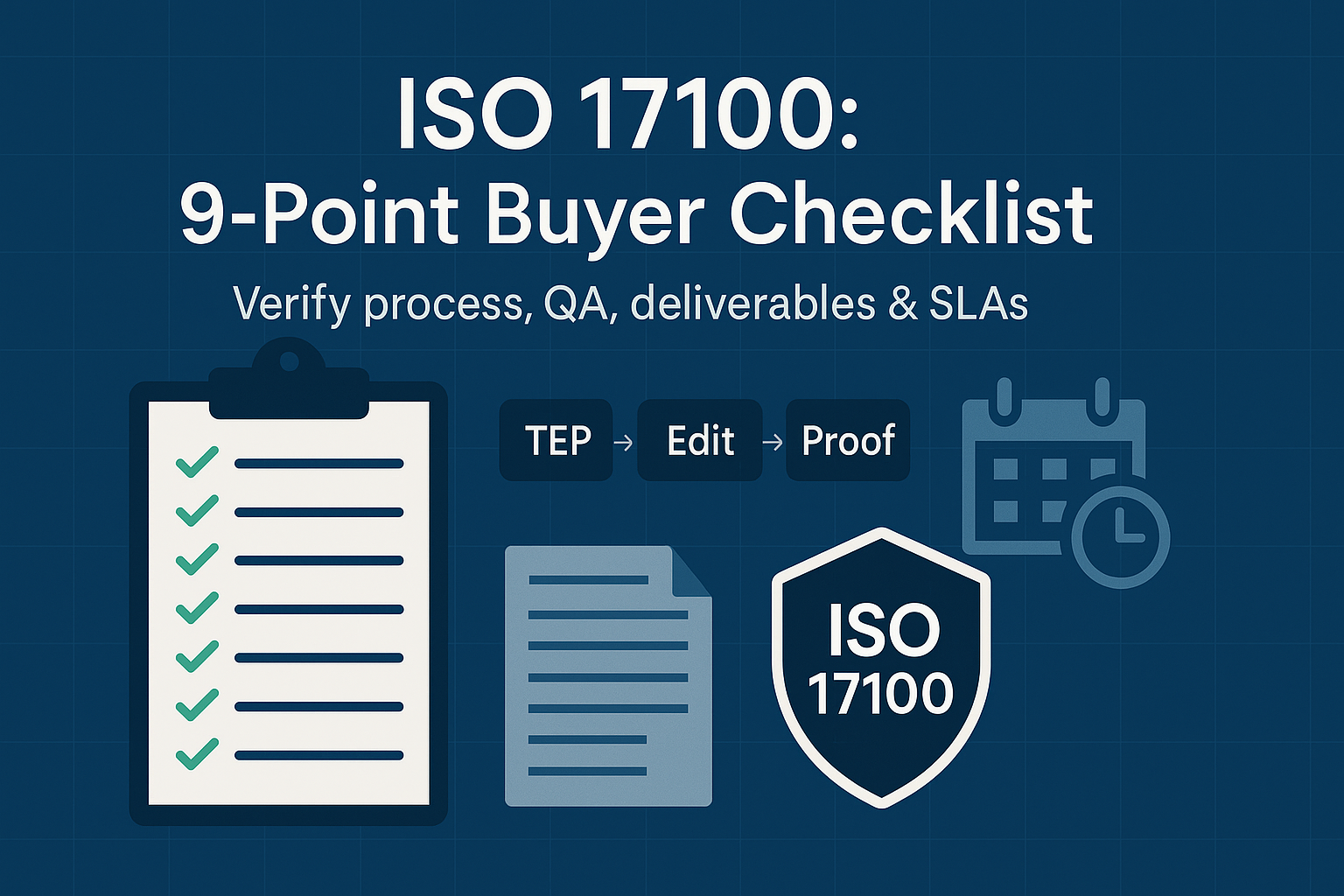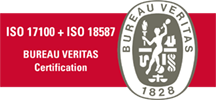How to Choose an ISO 17100 Translation Partner: A 9-Point Buyer Checklist
ISO 17100 certified translation services help legal, technical and product teams buy audited quality with confidence. This guide shows how to verify the process, deliverables and SLAs so you can select a partner who stands up to audits and real-world deadlines.

Table of Contents
What ISO 17100 certified translation services actually guarantee
ISO 17100 certified translation services codify how providers manage resources, project flow and quality assurance—so buyers don’t rely on promises alone. You’re not just getting a certificate; you’re buying a controlled production system with traceability, documented roles and mandatory review by a second linguist. For a quick primer on the standard itself, see the official overview from the International Organization for Standardization, and how M21Global operationalises those requirements within our translation services.
ISO 17100 defines professional competences, data protection, and record-keeping. It also requires bilingual revision by an independent reviewer, terminology management and client feedback loops. At M21Global, we pair those with our published quality control steps and continuous improvement routines to ensure repeatability across projects and sectors.
Aligning your risk profile with ISO 17100 certified translation services
Your risk profile should determine how strictly you apply controls. Regulatory submissions, contracts and safety documentation require the full ISO 17100 pathway, including independent revision and documented sign-off. Lower-risk content can retain terminology governance while relaxing turnaround constraints. When stakes are high, align your scope with our legal translation services or technical translation workflows so the controls match the consequences of error.
Handover to delivery: the TEP workflow you should demand
A compliant provider follows the TEP sequence—Translation, Editing (bilingual review) and Proofreading—under a defined process. Your project starts with qualification and briefing, then terminology setup, then translation by a native-level specialist. A second linguist performs a full bilingual edit, resolving terminology and style. Finally, proofreading polishes formatting, numbers and final consistency.
You should also see evidence of glossary creation, version control and change logs. Ask for examples of customised glossaries and how they propagate across updates. M21Global documents these steps in our rigorous review and continuous improvement pages, which map directly to auditor expectations.
9-point buyer checklist (with evidence to request)
- Certification scope & validity — Confirm the certificate references ISO 17100 and the legal entity delivering services. Cross-check the certificate number and audit cycle against the issuer’s register and the ISO overview for context.
- Named roles & competences — Ensure translators, revisers and project managers are assigned per role, with CVs and proofs of competence on file.
- TEP with independent revision — Require a second linguist to revise every word, not just spot-check. This is a core promise of ISO 17100 certified translation services.
- Terminology governance — Ask for glossary samples, rules for introducing terms, and how term changes are signed off. See our approach to customised glossaries.
- Traceability & records — Request samples of job tickets, checklists and revision notes (with sensitive data removed).
- Data security & confidentiality — Check policies and secure file handling across tools and suppliers.
- Sector alignment — Verify experience in your domain, plus sector-specific QA steps (e.g., numbers and units in engineering; clause references in contracts). Our certified translations page covers official use cases.
- Service levels & remediation — Define response times, delivery windows and what happens if quality issues arise. See our commitments on deadlines and quality.
- Referenceability — Ask for case studies or client testimonials that match your industry and content type.
Comparison tables: requirements, deliverables and turnaround SLAs
ISO vs non-ISO deliverables
| Area | ISO 17100 Pathway | Non-ISO Basic |
|---|---|---|
| Roles | Translator + independent reviser + PM | Single linguist or ad-hoc review |
| QA Artifacts | Brief, glossary, revision notes, change log | Brief only or informal comments |
| Traceability | Named resources, version control, audit trail | Limited or none |
| Risk Handling | Formal corrective actions | Best-effort fixes |
Auditor-ready documentation
| Document | Purpose | When You Receive It |
|---|---|---|
| Project brief & scope | Defines deliverables, SLA, constraints | On kick-off |
| Glossary & style notes | Ensures terminology consistency | Before T stage |
| Revision report | Records changes, justifications | After E stage |
| Delivery checklist | Confirms validations complete | With final files |
Typical SLA options
| Volume/Day | Review Level | Suitable For |
|---|---|---|
| 1,500–2,000 words | Full TEP | Legal, compliance, safety |
| 2,500–3,500 words | T + E (streamlined) | Product docs, support |
| 4,000+ words | T + spot-proof | Low-risk, internal comms |
How to validate claims before you sign
Perform a live pilot. Provide a representative sample and assess terminology setup, change notes and the depth of the bilingual review. Request the delivery checklist and compare it with ISO guidance (see the ISO 17100 overview) to ensure all mandatory steps are visible. Include a timing test that reflects your real-world bottlenecks, and add a remediation clause that triggers a second review at the provider’s cost.
For ongoing programs, schedule quarterly reviews and ask for continuous-improvement evidence. Tie this to your governance cadence so terminology, quality metrics and risks are reviewed regularly. Where appropriate, route critical content via our critical review pathway for an extra layer of assurance.
When ISO 18587 (MTPE) belongs in your stack—and when it doesn’t
Machine translation post-editing (MTPE) has its own standard, ISO 18587, which defines competences and process for editing machine output. It can reduce turnaround for large, time-sensitive volumes when paired with terminology controls and human revision. Review the ISO 18587 certification page to understand where it fits.
MTPE is not a replacement for the strict controls of ISO 17100 certified translation services. For high-risk content, keep full TEP and independent revision. For medium-risk content, consider a hybrid: MTPE for early drafts, followed by full bilingual editing on final releases.
Call-to-action: get an audit-ready quote
If you need ISO 17100 certified translation services with documented TEP, terminology governance and clear SLAs, request an estimate and a sample checklist now. We will map controls to your risk profile and share concrete artifacts before you commit. Start here: request a quote. You can also review our ISO 17100 certification summary for auditor-friendly details.
FAQ
Q1. How do ISO 17100 certified translation services differ from “quality assurance” claims?
A provider can claim “quality” without proving how they achieve it. ISO 17100 certified translation services, by contrast, embed quality into the production system. The standard requires role separation, documented competences, and full bilingual revision—an independent linguist must edit each translation. That means your deliverables come with traceability and a clear audit trail rather than informal checks.
The difference shows up when something goes wrong. With ISO 17100, remediation follows a defined path: root-cause analysis, corrective actions and documented prevention steps. You get visibility into who did what and when, plus the evidence to satisfy internal or external auditors. Without that framework, fixes are ad-hoc and hard to reproduce.
Q2. What evidence should I request to verify compliance before awarding a contract?
Ask for the certificate (with scope), a recent audit summary, and sample project artifacts: a filled-in brief, a glossary extract, revision notes and the final delivery checklist. These demonstrate the TEP process end to end. Cross-check the provider’s claims against the ISO 17100 overview and, where MTPE is proposed, the ISO 18587 standard. You should also run a small paid pilot using your real content to observe the workflow under realistic constraints.
Finally, confirm that named linguists and revisers meet the competence criteria (education and experience) and that their CVs are on file. This ensures the provider isn’t relying solely on tools or automation to meet your quality bar.
Q3. Does ISO 17100 increase turnaround time or cost?
The independent revision step adds effort, so timelines are slightly longer than single-linguist workflows. However, ISO 17100 certified translation services reduce rework by catching errors early and preventing defects from reaching production. Over a program’s lifetime, this usually lowers total cost of ownership by reducing change requests, legal exposure and support load.
Many buyers solve the turnaround challenge by tiering SLAs: use full TEP for high-risk content and streamlined review for lower-risk assets. Your provider should offer options and show how each choice affects risk, speed and budget.
Q4. When should I use ISO 18587 (MTPE) instead of ISO 17100?
Use ISO 18587 when volume and speed are paramount and the content’s risk profile is lower—knowledge bases, user-generated content and internal comms are good candidates. The standard ensures post-editors have the right competences and follow a defined process, giving you predictable quality at higher throughput.
Reserve the ISO 17100 pathway for legal, regulatory, medical, safety-critical and brand-defining material. If you do adopt MTPE for part of your stack, add checkpoints: terminology locks, human validation on critical sections and periodic audits to make sure output remains fit for purpose.
Image Suggestion (not published)
- Concept: A clean production “assembly line” metaphor—briefing, terminology, translation, bilingual review and delivery—shown as clear stations with people collaborating.
- Alt text: auditor reviewing ISO 17100 certified translation services workflow
- Suggested filename: iso-17100-certified-translation-services-workflow.jpg
Links
- Internal:
- External:

